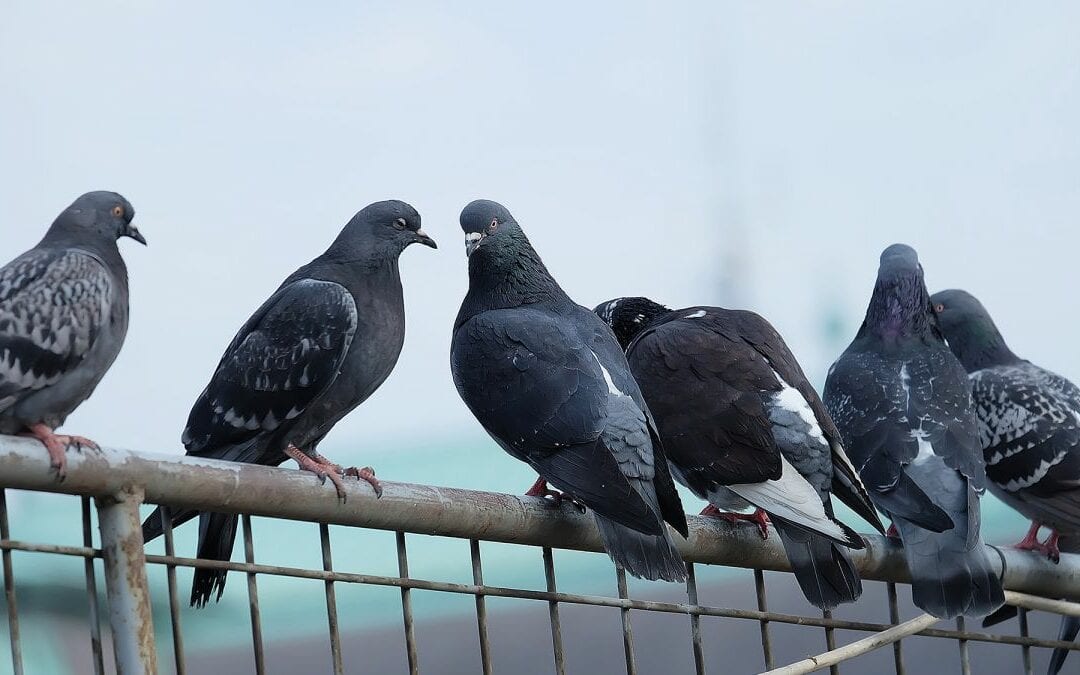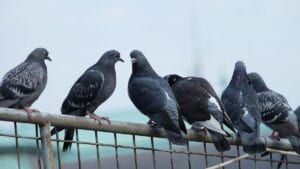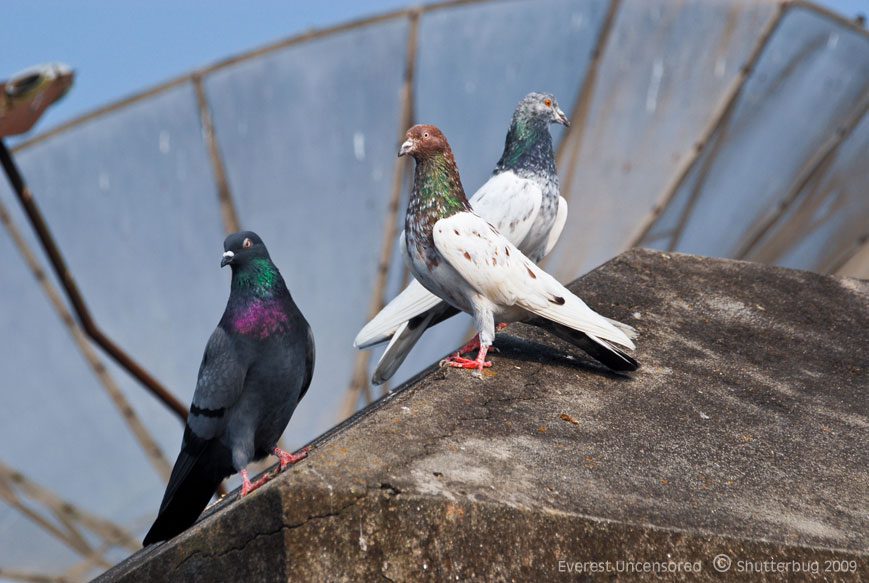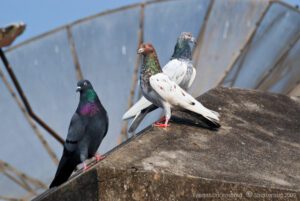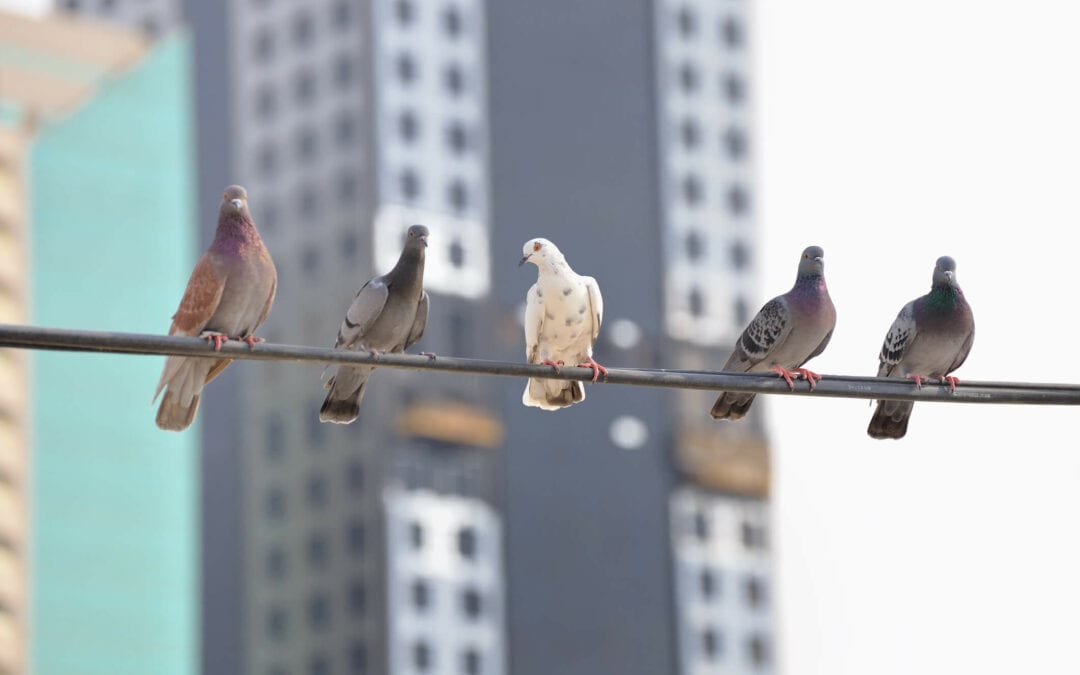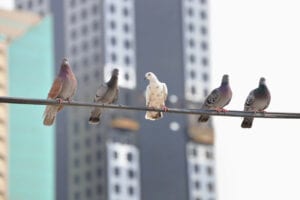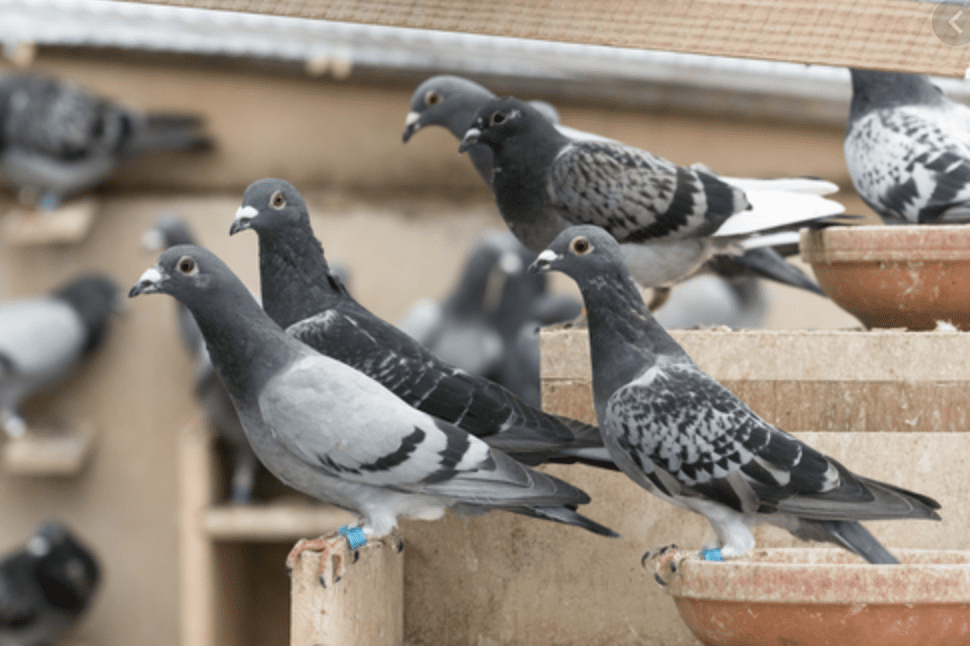
by Pigeon Patrol | Mar 7, 2022 | history of pigeons, MBCA, pet bird, Pigeon Control, Pigeon Droppings, Pigeon Patrol's Services, Pigeon Predators
Impatient for winter to be over, we had put on our boots to go seeking signs of spring but had instead found a sign of the previous summer. We must have walked past this thicket a score of times last summer without ever noticing birds around it, but here is a bird’s nest among the branches, at eye level, in plain sight now that winter has stripped away the last of the leaves.
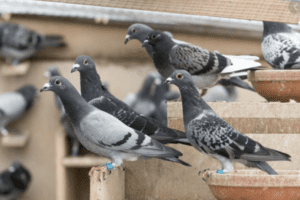
It would be easy enough to pass it by. If we pause to look closely, though, it becomes more intriguing. We may never know what kind of bird built the nest, because there are several species here that might construct this type: an open-cup shape lashed into a three-way fork in an upright twig. But it inspires a sense of wonder beyond mere questions about identification. Somehow a small bird knew how to gather the myriad materials for this structure. Somehow this bird arranged scores of small pieces of twig and grass and weed and bark, weaving them together with such precision that the nest is still sturdy and secure after being exposed to the winter’s rain and wind. Considered in the proper light, this little bundle of dried vegetation is really a small miracle.
“My favorite palette is the color of winter decay,” says photographic artist Sharon Beals. It’s 7 a.m. in San Francisco, but she is already on her way out the door to work on her project for the day. Much of her professional photography takes her outside, “wandering a river for hours, looking at bugs, muck, and minnows,” as she says, or photographing native plants or their pollinators. Today, though, she will spend up to 11 hours in a museum, examining birds’ nests and photographing many of them. The results will add to her growing collection of nest portraits—extraordinarily detailed images that have already wowed scientists and artists alike.
Beals became immersed in this subject almost by chance when a friend, knowing her fascination with the subtle minutiae of nature, brought her an abandoned bird nest. Studying it, she knew she had to find a way to capture its intricacy. Using a very high-resolution flatbed scanner, she made images of this nest, and then another, and another.
But problems loomed. For one thing, she says, after turning a nest upside down on the scanner, she might have to spend hours cleaning all the dust that falls from the nests off the images in Photoshop. For another, as she discovered, possessing these nests was illegal.
Beals overcame the first challenge by moving to very high-resolution cameras and by taking multiple exposures, focusing on different planes, then melding the images together. But the second problem was tougher. The laws protecting U.S. birds are far more sweeping than most people imagine. Without special permits, it is illegal for private citizens to possess most species of native birds, or their feathers, or their eggs, or even their abandoned nests. The laws may seem excessive, but they were enacted at a time when our birds were under siege from commercial plume hunters and recreational egg collectors, and they were written to be wide-ranging and inclusive. Rather than give up or break the law, Beals turned to the Museum of Vertebrate Zoology and the California Academy of Sciences, and soon had permission to come in and photograph nests from among the hundreds in the institutions’ specimen collections.
The popular image of natural history museums may be of a handful of stuffed creatures on public display in glass cases, but most keep the majority of their specimens in research collections out of public view. The nests at the California Academy of Sciences were mostly collected decades ago, at a time when relatively little was known about birds’ habits. These specimens provided basic data points then, and they continue to be scientifically valuable today.
For Sharon Beals, they also provided a treasure trove of artistic possibilities. She spent days at the academy, examining and photographing nests. “These first images gave me the satisfaction of seeing the materials on almost a cellular level,” she says. “I loved the quiet, subdued palette, and the shapes created by the form-follows-function art of the nest builders themselves. I loved the amazing variety of content and construction, the way the materials became like line and brushstroke.” When she began printing the images larger than life, on sheets of fine etching paper two feet across, others shared her enthusiasm. Visitors to her studio were fascinated. Almost invariably they became intensely curious. Beals had found a way to make people see the nests, truly see them, as cause for wonder and for endless questions about the birds that built them.
Birds do not live in their nests the way humans live in their houses. A few species, such as some wrens, will use them as shelters to sleep in at night, but they are the exceptions. For the majority, the nest is just a cradle. Built to hold the eggs and the helpless young, it is abandoned once the young birds are old enough to leave. In most cases it is never used again.
There is evidence that some dinosaurs built primitive nests on the ground and even cared for their hatchlings there. Today many creatures besides birds—from wasps to mice to alligators—shelter their young or their eggs in nests that they construct themselves. But for variety of placement and material, and for sheer complexity of design, nothing can compare with birds’ nests. Especially among smaller birds, nests are often remarkable for their inventive use of local materials to provide support, shelter, and camouflage. The nests are tiny marvels of disposable architecture.
The skill to create them comes almost entirely from instinct (although there is evidence that young adult birds, making their first nests, do improve with practice). Studies have shown that at least some birds, hand-raised in captivity, can build a nest typical of their own species without ever having seen one. The instinct to do this must be flexible, because the locations and materials available for nests in the wild vary, but it must be based on a considerable amount of precision as well.
Even a small bird’s relatively simple nest may be composed of several kinds of material used for different purposes. For example, a white-crowned sparrow’s may have coarse twigs at the base, finer twigs and weeds intertwined with rootlets and bark strips to form the open cup, dry leaves in the outer edge, and fine grasses and other soft materials molded into an inner lining. And that’s just a simple number. A more complex nest, such as the long hanging pouch of an American oriole, may involve actual weaving or sophisticated knots tied in long plant fibers, and it may take days of intense effort to build.
Most birds are opportunistic when it comes to building materials, and will readily incorporate manmade items into their nests if they fit basic requirements of size and texture. Paper, string, nails, pieces of wire, and bits of fabric regularly show up in the handiwork of suburban birds. In some areas house finches have become a minor nuisance by dismantling nylon window screens to use the strands for their nests.
In many cases, though, the materials chosen must have specific properties. Studies of nesting European starlings have found that the birds were selecting certain plants, such as wild carrot and yarrow, containing chemicals that would inhibit the growth of mites and other parasites. In eastern North America the great crested flycatcher often adds a piece of shed snakeskin, and the power of suggestion imparted may help deter predators or other intruders. Chipping sparrows often use animal hair (gathered in farmyards, or even plucked from startled pets) for their nest lining. Feathers are also ideal for soft, insulating lining material. Big birds like quail or ducks use their own down feathers for this purpose, but swallows and other small birds prefer feathers dropped by larger birds. A truly extreme example of material gathering is practiced by certain tropical swifts, fast-flying small birds that will actually strike much larger birds in midair to knock feathers loose.
As a very general rule, females are the skilled builders. For many species they do all the construction, including some (such as hummingbirds) for which males abdicate any responsibility for helping with the nest or young. In other cases, the male provides the basic foundation and the female adds the detailed lining. A male marsh wren may build 20 or more “dummy nests” around his territory; the female chooses one, adds lining, and uses it as the actual site for the eggs. The male’s building spree is not wasted effort: The presence of all those decoys may provide some protection for the real one, as predators tire of raiding nests that turn out to be empty.
Some of the most impressive nests are also among the smallest. A hummingbird nest is a wondrous creation of tiny plant fibers, mosses, and spiderwebs, so small that a 50-cent piece would completely cover it. It is as soft as felt but strong, with the spiderwebs making it pliable enough to stretch and expand as the rambunctious young hummers grow and exercise in it. Many hummingbirds will camouflage the outside with bits of lichen. At a distance such an object looks, for all the world, like a natural bump or knob on the branch, thereby deceiving potential predators in the mother bird’s absence.
At the opposite extreme are eagles. A pair of bald eagles may use the same nest for years, adding material to it annually until it becomes huge (an extreme example can reach a depth of 20 feet and a weight exceeding two tons). Such a nest is merely a ramshackle heap of sticks, hardly an admirable piece of avian architecture, but it does have its admirers: House sparrows and other small birds sometimes tuck their own nests into the lower crevices, and great horned owls may commandeer the entire nest, perhaps even driving the eagles from their aerie.
The finest nests are crafted by smaller birds, however, and the majority are never reused, not even by their original builders. It seems all the more remarkable that birds should create these intricate structures for such ephemeral use. It seems ironic, too, that most of us are not legally allowed to possess these nests, even after they have been abandoned. But when we are lucky enough to find them in the wild, or see them revealed in works of photographic art like the ones reproduced here, we cannot avoid holding them and the birds that made them in absolute awe.
Source
Pigeon Patrol Products & Services is the leading manufacturer and distributor of bird deterrent (control) products in Canada. Pigeon Patrol products have solved pest bird problems in industrial, commercial, and residential settings since 2000, by using safe and humane bird deterrents with only bird and animal friendly solutions. At Pigeon Patrol, we manufacture and offer a variety of bird deterrents, ranging from Ultra-flex Bird Spikes with UV protection, Bird Netting, 4-S Bird Gel and the best Ultrasonic and audible sound devices on the market today.
Voted Best Canadian wholesaler for Bird Deterrent products ten years in a row.
Contact us at 1- 877– 4– NO-BIRD, (604) 585-9279 or visit our website at www.pigeonpatrol.ca
Pigeon/Pigeon Patrol / Pigeons Roosting / Vancouver Pigeon Control /Bird Spikes / Bird Control / Bird Deterrent / Pigeon Deterrent? Surrey Pigeon Control / Pest /Seagull deterrent / Vancouver Pigeon Blog / Birds Inside Home / Pigeons in the cities / Ice Pigeons/ What to do about pigeons/ sparrows , Damage by Sparrows, How To Keep Raccoons Away, Why Are Raccoons Considered Pests/ De-fence / Pigeon Nesting/ Bird Droppings / Pigeon Dropping/ woodpecker control/ Professional Bird Control Company/ Keep The Birds Away/ Birds/rats/ seagull/pigeon/woodpecker/ dove/sparrow/pidgeon control/pidgeon problem/ pidgeon control/flying rats/ pigeon Problems/ bird netting/bird gel/bird spray/bird nails/ bird guard

by Pigeon Patrol | Feb 22, 2022 | history of pigeons, MBCA, pet bird, Pigeon Control, Pigeon Droppings, Pigeon Patrol's Services
Pirates, predators, power lines and poor luck — they brave it all for hundreds of miles, while carrying along the million-dollar hopes of the haves and have-nots. Pigeons are the new thoroughbreds in China and everyone has taken notice — breeders in Europe and even the feed industry in the United States.
Pigeon racing goes back hundreds of years and probably a lot longer. The races are held in countries across the globe, but the sport is at fever pitch in China. From Vice: “Twenty years ago — sort of a poor man’s delicacy, but now with the new Chinese economy, it’s become a rich man’s play thing.”
China’s nouveau riche love designer handbags, the finest wine, and sleek cars — but they’re also quick to slap down bags of cash on a pigeon. Money is swirling around Chinese pigeon racing, and the torrent shows no signs of abatement. In 2011, a Chinese entrepreneur payed $200,000 for a pigeon — Blue Prince — at PiPa, the world’s premier pigeon auction house located in Belgium. PiPa sold 218 pigeons that day — for an astounding $1.8 million.
And in 2013, PiPa sold Bolt (named after Olympic sprinter Usain Bolt) to another Chinese businessman for $400,000. An entire lot of 530 Belgian-bred pigeons went for almost $6 million that day, with nine of the 10 most expensive birds headed to China or Taiwan. (In 2009, The Telegraph reported that Chinese mafia gangs were hitting Belgian pigeon coops and stealing the prized birds. “Rather than attempting to smuggle their prey abroad, criminals will kill the pigeons and cut of their identifying rings to be used on much less valuable birds bred in Asia.”)
Blue Prince, Bolt and the other auction birds weren’t bought to race; they are strictly for breeding. As PiPa’s Ya Minna told The Independent, “A pigeon is a far better investment than a fine bottle of vintage wine. You can breed it; it will have children and grandchildren.”
Pigeons may look ordinary, but the actual races are a subculture of chaos. With entry fees ranging from a $200-$1,000, several thousand birds are loaded onto a communal truck and the trek to the starting line begins. The winner will not be the first pigeon to return. The birds are all banded with GPS locators and when they arrive home at their individual coops, a scanner records the arrival time and the winner is determined according to which pigeon flew home at the highest average speed. (This is a sport tailor-made for hijinks and corruption.)

The long haul home
The truck may drive 500-700 miles away, and then the birds are released as the marathon begins. Pigeon pirates are on alert, hoping to catch returning birds to sell on the black market; hawks are always on the prowl; bad weather may claim birds; and disorientation may be a factor.
This is no horse race with a two-minute hurtle towards euphoria or dejection; it’s a dry-mouth game of patience for the pigeon owners and bettors. The wait will last hours; and depending on whether it gets dark and the pigeons roost, it may lapse into the next day.
When the birds arrive home (the strongest birds will fly 600 miles without stopping), the tabulations are made, and the results are announced over the Internet and text. The winners gloat and count their cash; the losers lick their wounds; and the breeding begins.
With the glut of cash in Chinese pigeon racing, the U.S. feed industry has taken note. Jos Zamzow, Meridian, Idaho, believes his family company, Dynamite Marketing, has perfected a high-performance pigeon feed. The News Tribune reports that Zamzow’s first test shipments of the feed concoction will arrive in Taiwan this summer. “After they start winning races, we expect there will be significant demand … pigeon racing is popular all over Asia.”
Zamzow already markets pet and pork feed in Taiwan. “Now Zamzow is betting that Dynamite can transform Idaho-grown safflower and corn — and a top-secret, blood-boosting brew of mushroom powder and yeast cell wall extract it makes in its 102-year-old feed mill — into an annual export business worth up to $15 million.”
Spiraling pigeon auction prices, criminal bird gangs, and a mad gambling boom — a fitting backdrop for a capitalist sport once banned by Chairman Mao.
Source
Pigeon Patrol Products & Services is the leading manufacturer and distributor of bird deterrent (control) products in Canada. Pigeon Patrol products have solved pest bird problems in industrial, commercial, and residential settings since 2000, by using safe and humane bird deterrents with only bird and animal friendly solutions. At Pigeon Patrol, we manufacture and offer a variety of bird deterrents, ranging from Ultra-flex Bird Spikes with UV protection, Bird Netting, 4-S Bird Gel and the best Ultrasonic and audible sound devices on the market today.
Voted Best Canadian wholesaler for Bird Deterrent products ten years in a row.
Contact us at 1- 877– 4– NO-BIRD, (604) 585-9279 or visit our website at www.pigeonpatrol.ca
Pigeon/Pigeon Patrol / Pigeons Roosting / Vancouver Pigeon Control /Bird Spikes / Bird Control / Bird Deterrent / Pigeon Deterrent? Surrey Pigeon Control / Pest /Seagull deterrent / Vancouver Pigeon Blog / Birds Inside Home / Pigeons in the cities / Ice Pigeons/ What to do about pigeons/ sparrows , Damage by Sparrows, How To Keep Raccoons Away, Why Are Raccoons Considered Pests/ De-fence / Pigeon Nesting/ Bird Droppings / Pigeon Dropping/ woodpecker control/ Professional Bird Control Company/ Keep The Birds Away/ Birds/rats/ seagull/pigeon/woodpecker/ dove/sparrow/pidgeon control/pidgeon problem/ pidgeon control/flying rats/ pigeon Problems/ bird netting/bird gel/bird spray/bird nails/ bird guard

by Pigeon Patrol | Feb 16, 2022 | Bird Spikes, Columbidae, Doves, history of pigeons, MBCA, pet bird, Pigeon Control
It’s no secret big cities have pigeon problems. Toronto is no exception. Like rats in the middle ages, the disease-carrying vermin spent the past decade running amok and increasing their numbers. It was my job to try and keep Toronto’s ever-growing pigeon population in check. Thankfully, I came across an article about a pilot project where researchers replaced pigeon eggs with wooden substitutes. The birds, too stupid to know the difference, spent months caring for the fake eggs instead of producing more. The project was a huge success, and the pigeon population decreased significantly in a short amount of time. It sounded like the perfect plan, so I implemented the solution in my city.
What I didn’t count on was for those fake eggs to hatch, and for the abominations inside to be released into the world.

Clint, my partner, came in one morning carrying a large wooden crate with straw poking out of every crevice.
“Looks like Christmas came early this year,” he said, “What is this stuff?”
I excitedly walked over, helping him set the box down on a workbench.
“This,” I said, prying it open to reveal its contents, “is the solution to our pigeon problem.”
Reaching inside, I took one of the eggs. I was a little disappointed to see that they weren’t wooden, as promised. Instead, they were thin, light, and hollow like those cheap plastic Easter eggs. It wasn’t close to what I was expecting.
Oh well, that’s what you get for ordering off of Ebay, I thought.
Clint took a handful of the eggs.
“These are the replicas you ordered? They don’t feel remotely the same as the real deal.”
We were well aware of what the eggs felt like. Up until then, the only way to decrease the pigeon population was to sneak into their nests and steal the eggs. It was a futile, temporary solution, because the birds would just lay new eggs once they realized theirs were gone. That’s what made the idea of using substitutes so damn good.
“It’s fine, Clint. They don’t have to fool us, they just have to fool the pigeons. This’ll work, trust me,” I answered.
I was right: the pigeons fell for it, hook, line, and sinker.
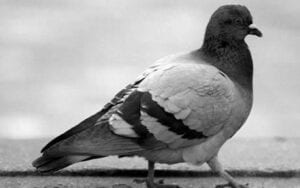

A few months passed, and we started seeing a decline in the amount of younger birds in the area. I can’t tell you how proud I was of what I’d done. I’d found a safe, environmentally friendly way of dealing with the flying rats, at the cheap cost of a few hundred dollars and an elevator trip to pigeon nesting grounds atop high-rise rooftops around the city.
The problems started about three months in. Clint and I were inspecting nests on opposite sides of the city. I was halfway up the building when Clint called me.
“Yo,” I answered.
The sound of wind could be heard in the background. Evidently, Clint had reached his destination.
“Hey. Some of our eggs broke,” he announced.
The elevator came to a stop, doors swinging open to let me off. I stepped out and made my way to a small staircase leading to the rooftop.
“We’ll just have to replace them. No big deal,” I answered nonchalantly.
There had been a few violent storms since our last inspection, and I figured the eggs must have fallen from the nests and shattered on impact. See, this is why wood would have been better, I grumbled to myself, as I exited onto the rooftop for my inspection.
“Well, fuck,” I said.
“What?” answered Clint.
Most of my eggs were broken, too. The strange thing was that they were still tucked in the nests, right were we’d left them. Had the pigeons figured out our ploy and attacked the replicas? Were the fake eggs too frail to survive our harsh Canadian weather?
I groaned.
“It’s the same here. We’re going to have to start over,” I told him, defeated.
Clint laughed.
“It’s all good, we can hatch a new plan.”
I paused for a moment.
“Did you just-” I began, but he interrupted.
“Just look on the sunny side up of things, yeah?”
Puns. At a time like this. Puns.
“Don’t yolk with me,” I replied, with a sigh.

We couldn’t leave the nests unattended for too long, otherwise all our progress would go down the drain. I sent Clint to replace the broken eggs with what was left from our original order. In the meantime, I searched online for anyone selling wooden eggs. Unfortunately, the cheapest – and fastest shipper – was the person we’d ordered from the first time around. We needed these eggs quickly, and our budget was pretty tight. I figured I’d order the subpar eggs one more time. If they lasted long enough for city officials to see the plan was working nicely, I was sure I could convince them to increase our budget so we could order better supplies next fiscal year.
Just to be sure the pigeons weren’t attacking our fake eggs, I also set up a security camera on one of the rooftops. I needed to know if they’d gotten wise to our ruse, though I highly doubted they had the mental capacity to do so. Still, the project would prove fruitless if the birds weren’t fooled by our cheap imitations, so it was best to keep an eye out.

Over the course of the following weeks, I started getting strange reports about small animals behaving in a bizarre manner. Frankly, I didn’t pay much attention to them, at first. They sounded a little insane, to tell the truth. One woman claimed she’d seen a pigeon climb a tree. She said he crawled up the bark like a squirrel. Another report stated that a chipmunk had been seen attacking – and killing – a neighborhood dog. Another witness called in about an injured cat, but when he investigated, all he found was a pelt.
By the time I read the fifth report, I was starting to get a little worried. What was even more troubling to me was that these reports were coming from all over the city. If it had been confined to a single neighborhood, I would have suspected an outbreak of rabies, or a new disease of some sort. But the reports were coming in from all around Toronto and its suburbs, which span an extremely large area. How could anything spread so quickly? It had to be something else.
I was just about to do a bit of research on the subject when Clint came in, wearing a scowl.
“Broke. Shitty fucking eggs broke again,” he grumbled, throwing himself on his chair.
I forced a grin.
“Crack a smile, would ya?”
He tossed his worksheet on the table.
“That was an egg-cellent pun,” he replied, releasing a single chuckle.
“You remember to bring the footage?” I asked him.
He unzipped his coat and reached into his pocket for an SD card, “Gotcha covered. Movie time!” he chirped.
We uploaded the footage and took a look.

Pigeons.
Pigeons sitting on their nests.
Pigeons preening.
Pigeons flapping their wings at one another.
A squirrel.
A squirrel getting chased away by birds.
More pigeons.
It must have been the dullest security tape in the world. The kind of footage that even David Attenborough’s lovely voice wouldn’t be able to save. We fast-forwarded through days of pigeons doing pigeon-y things. Never once did they show any violence towards our replica eggs.
Clint had dozed off by the time something finally happened on-screen. The only reason I was still conscious was due to the copious amount of coffee I’d ingested that morning.
It was dead of night. In the video, at least. One of the birds flew off its egg and perched itself on the nest, peering inside. This is it, I thought, leaning closer to the screen. I figured he’d attack the egg, but I was wrong.
I watched as the video soundlessly continued, and something cracked open the egg – from the inside. My jaw gaped open. This wasn’t possible: the eggs were plastic shells. The only explanation was that we’d missed one real egg somewhere in the bunch. Yeah, that had to be it. I was witnessing the birth of a baby pigeon, nothing weird.
Except baby pigeons don’t look like smoke.
A puff of dark air came out of the egg. The pigeon, head inches from it, inhaled the gassy substance. It reared back and stood completely still for about a minute, before falling over. I watched as it started thrashing violently, like it was having a seizure. Then, from its beak spewed some kind of chunky liquid that evaporated as soon as it hit the air. The pigeon’s body seemed to deflate like a balloon, as though the creature was being hollowed out. I was left staring incredulously at the flat, immobile husk of what had once been a pigeon.
Suddenly, the pigeon’s chest bulged out and the animal regained its form. At least, sort of. Its proportions were all wrong: its wings were bloated and angled oddly, most of its girth was in its neck rather than stomach, and its midsection had stretched out unnaturally. It was like looking at an animal pelt draped over the wrong mound. Like a lunatic taxidermist’s cruel experiment. The abomination of nature jerked its head towards the ledge. It twisted onto his back, legs contorting and dislocating in such a way as to be able to reach the ground. From its throat, I could see stump-like arms stretching out, clawing at the cement rooftop. In quick and jagged movements, the creature skittered over the edge, and disappeared from view.
I was shocked, unable to believe what I had seen. I had to watch and re-watch the video several times, before it occurred to me to wake Clint up. He grumbled unhappily, rubbed his tired eyes, and looked at me.
“You won’t believe this,” I uttered.
I rewound the footage and pressed play. His eyes widened with the same disgusted disbelief as mine. Even on my fifth viewing, I couldn’t wrap my head around it.
“This is bad,” he said.
“… I know,” I answered.

After watching the video a few more times, we went home. I think we both hoped a good night’s sleep would help clear our minds. Maybe, upon reviewing the tape, we’d realize we were mistaken. Maybe it was a trick of the light? Unlikely, but we could only hope.
Clint was already at work when I came in. His eyes were glued to the screen.
“Watching it again?” I asked.
“Not exactly,” he replied, “… I … kept going.”
I approached the desk and peered at the monitor.
“Kept going?” I questioned.
His face was pale and his eyes weighed down by large bags. How long had he been here? Had he come in extra early?
“There was two days left of footage on the card,” he explained.
“And you went through it?”
“Yeah…”
“Did you see…more of those things?”
Clint pressed his lips together, “Yeah…and…some of them came back,” he explained.
I raised my eyebrows, looking closer at the screen. I noticed something odd about one of the nests. There were multiple eggs resting in the sunlight. They were neither genuine pigeon eggs, nor replicas. They were too big for that.
Clint pointed to the batch, his hand trembling.
“It laid them,” he murmured.
I felt a flush of nervous energy climb up my spine like an elevator, and then turned to the reports I’d been reading the day before. Were the eggs at the center of it all?
“We need to call the authorities,” I uttered shakily.
“We ARE the authorities,” he replied, his voice sounding frantic.
I paced around the room. Back and forth, back and forth, like a pendulum.
“It laid them.”
The phone rang, interrupting my anxious march. It was another report of odd animal behavior. This time, the culprit was a deer. In a spooked and almost disgusted tone of voice, the woman on the line explained that she’d seen a deer slithering along the river. She said its body was sideways, but its head was upright. Oh god, I thought. What ever those things were, they could affect larger animals. While I tried to comfort the worried caller, I heard something from Clint’s workstation.
Crack
I turned around, only to see a puff of smoke rising towards my coworker. Near his keyboard was a cracked shell, just like the ones on the rooftop. Without a word, Clint bolted to the bathroom, holding a hand over his mouth as though about to puke. I dropped the phone and ran over to the door. It was locked.
“Clint … are you okay?”
Silence.
Silence.
Silence.
All of a sudden, I heard him heaving violently. A sound of moist gurgling and boiling water erupted from the bathroom. Terrified of what would happen if Clint got out, I pushed the heavy workbench in front of the door. I stood in terrified silence as the noise came to a stop. Was Clint now lying as flat as a pancake against the porcelain throne? Would it turn into some sort of bastardization of a human body, like what happened to the pigeon?
Silence.
Silence.
Silence.
BANG
Clint threw himself against the door violently. Just one blow nearly threw the thing off its hinges. Again and again, he slammed himself against the surface, causing the workbench I’d placed in front of it to slowly inch away. All I could do was push myself against it to try and keep the door closed. My only thoughts were to keep him from escaping, for my own safety. I knew he’d attack me if I let him out. I just knew it.
The sound came to an unexpected halt, allowing me to breathe a sign of relief. Maybe he’d expired. Maybe that thingneeded fresh air to survive. Whatever the reason, I thought I was safe.
But then, I heard a crash. The window. I’d forgotten all about the bathroom window.
He’s out there now. Him, and those other mutated atrocities. I don’t know what they are or what they want. All I know is that they’re roaming the city right now, doing god knows what. Most of them probably look like pigeons, but they can be anyone or anything. I just hope someone figures out how to stop them because, at last count, there were over 700 of those cursed eggs planted around Toronto. Now that I know these things can reproduce, god knows how many more eggs might be out there.

Update 1:
He came back…
I should have known he’d come back.
He warned me before: he said the creatures on our recording returned to its nest to lay their eggs. Those monsters seemed to have the salmon mentality: going back to their place of birth when it came time to reproduce.
Too busy answering a slew of panicked calls – all the while panicking myself – I didn’t hear him when he came in through the front door. Thankfully, I caught a shape from the corner of my eyes. Without even finishing my sentence, I dropped the phone and locked myself in the maintenance closet, praying he hadn’t seen me.
Outside the thin wooden door, the room was quiet.
If he was breathing, I couldn’t hear it. His footsteps were just as silent. Had I overreacted? I hadn’t actually seen Clint, just a shadow in my peripheral vision. Maybe it was my imagination. I needed to know, so I knelt down, peered through the crack under the door, and closed an eye to get a better look.
I wish I hadn’t. I wish I could erase that thing from my mind, to preserve Clint’s memory as the man I knew him to be. Not that. Anything but that.
What I saw was a mess of flesh inching along the floor like a slug. I couldn’t figure out what was facing up: his back or his chest. His spineless torso had folded over, bringing his arms nearly perfectly in-line with his legs. His head, now completely shapeless, lay flat at his midsection. His mouth reminded me of the figure in Munch’s famous painting, The Scream. His greyed eyes stared at me, but I could tell, as he continued to slither towards his desk, that they were useless decorations.
He disappeared from view.
Then, came a horrid sound: a squishy and gooey noise that reminded me of the old slime ball toys I used to play with as a child. It lasted a few moments, stopped, started again, and then stopped for good.
Shaking in my boots, I remained concealed in my dark prison all day, ignoring repeated hunger pangs and my own instinct to run. I couldn’t afford the risk of being caught. As day shifted into night, I began to wonder if I could sneak past him. On our security tape, I’d seen normal pigeons sitting on nearby nests, seemingly unfazed by the creature. Maybe Clint wouldn’t attack me. I had to take the chance: I couldn’t hide forever.
As quietly as I could, I swung the door open and stepped into the office. The thing wearing Clint’s skin was gone.
Thank god, I thought.
Out of morbid curiosity, I glanced at his workstation, where I’d heard the unsettling noises earlier. There were two massive eggs sitting on his desk, coated in a viscous substance. I didn’t even want to think of the implications. I didn’t want to know out of which orifice he’d laid them. I wanted nothing to do with this anymore.
I ran out of the office, to my car, and drove straight to Kingston.
I’m not going back. I will never go back. Someone else will have to deal with this situation.

Update 2:
I thought I could get away from them, but now, I’m not so sure. Maybe I’m imagining it, but the pigeons outside look … odd. Not as disproportionate and disfigured as what I saw in Toronto, but … there’s something wrong about the way they move.
I think those things are learning to better mimic the shape of what they’re possessing. And now, they’ve spread.
Source
Pigeon Patrol Products & Services is the leading manufacturer and distributor of bird deterrent (control) products in Canada. Pigeon Patrol products have solved pest bird problems in industrial, commercial, and residential settings since 2000, by using safe and humane bird deterrents with only bird and animal friendly solutions. At Pigeon Patrol, we manufacture and offer a variety of bird deterrents, ranging from Ultra-flex Bird Spikes with UV protection, Bird Netting, 4-S Bird Gel and the best Ultrasonic and audible sound devices on the market today.
Voted Best Canadian wholesaler for Bird Deterrent products ten years in a row.
Contact us at 1- 877– 4– NO-BIRD, (604) 585-9279 or visit our website at www.pigeonpatrol.ca
Pigeon/Pigeon Patrol / Pigeons Roosting / Vancouver Pigeon Control /Bird Spikes / Bird Control / Bird Deterrent / Pigeon Deterrent? Surrey Pigeon Control / Pest /Seagull deterrent / Vancouver Pigeon Blog / Birds Inside Home / Pigeons in the cities / Ice Pigeons/ What to do about pigeons/ sparrows , Damage by Sparrows, How To Keep Raccoons Away, Why Are Raccoons Considered Pests/ De-fence / Pigeon Nesting/ Bird Droppings / Pigeon Dropping/ woodpecker control/ Professional Bird Control Company/ Keep The Birds Away/ Birds/rats/ seagull/pigeon/woodpecker/ dove/sparrow/pidgeon control/pidgeon problem/ pidgeon control/flying rats/ pigeon Problems/ bird netting/bird gel/bird spray/bird nails/ bird guard
